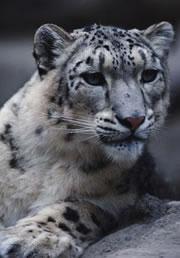 Big cats sport complicated coat patterns.© Getty
Big cats sport complicated coat patterns.© GettyNo one knows quite how animals with flashy coats get their patterns. But an equation developed by Alan Turing in 1952 is good at producing dead ringers for zebra hides and leopard spots1. Now, the equation has been used to model how spots can morph to more complex patterns as an animal ages.
Turing supposed that coat patterns could be produced by two chemicals, which he called 'morphogens', interacting on the more or less two-dimensional space of the hide. If one morphogen causes hair to turn black, for example, and another causes it to remain pale, then differences in the rates at which these chemicals diffuse through the coat, along with various reactions between the two, would determine the patterns.
Turing called them 'reaction-diffusion equations'. By tweaking the variables of diffusion speed and other behaviours of the morphogens, researchers have been able to use these equations to replicate familiar coat patterns.
If one morphogen makes black hairs but also activates the morphogen for paleness, for example, and it diffuses faster than the pale morphogen, this could explain one type of spot seen in some coats: a random clump of black morphogen would diffuse outwards, activating and leaving slower pale morphogens in its wake, creating a black ring.
Baby spots
But adult big cats have much more complicated patterns. While kittens have simple spots, a close examination of a leopard-print rug will show that adult leopards have patterns more like broken circles. Adult jaguars have an even more complex pattern — polygons with small dots in the centre.
Sy-Sang Liaw of National Chung-Hsing University in Taichung, Taiwan, and colleagues set out to replicate these patterns using Turing's equations. But they found they had to do more than just tweak the parameters of the reaction-diffusion equation. Instead they had to assume two stages of spot growth with different rules: the first to get the baby cats their spots, and the second to create the final configurations. It took them a year to find a final solution.
"The pattern of the jaguar was the hardest part," says Liaw, who reports the work in Physical Review E2. "People who try to do the pattern with one stage only will never get it. You have to separate it into two stages."
Two step
ADVERTISEMENT
Anotida Madzvamuse, a mathematician who has worked on Turing models at Auburn University in Alabama, says the difficulty of the jaguar pattern intrigues him. "It would be nice to know why it is impossible to get it in a single stage," he says.
No one has found a physical manifestation of morphogens, so it is unclear how the patterns created by these equations are actually made in a real cat. Adding two sets of rules for the morphogens complicates the picture even further. If it is a true reflection of what happens in cats, this means something to do with the animal's age must flip a switch in the biological rules by which their coat colours behave.
"Maybe the parameter values could be related to the size of the animal," Madzvamuse suggests.
Visit our aleopardchangeshis_spot.html">newsblog to read and post comments about this story.
Chung-Hsing University, Taichung, Taiwan
